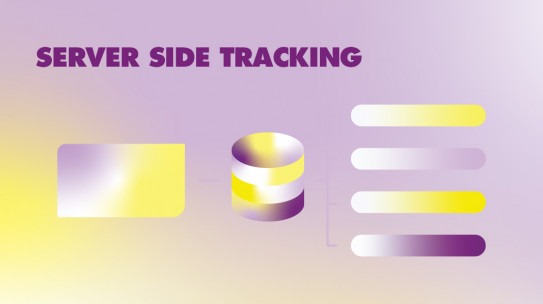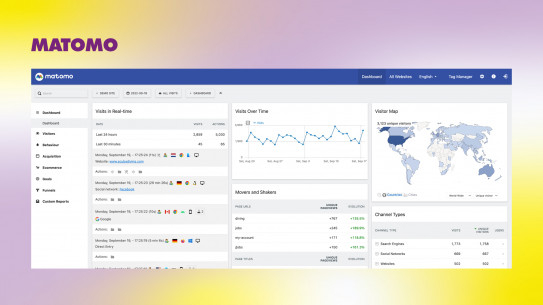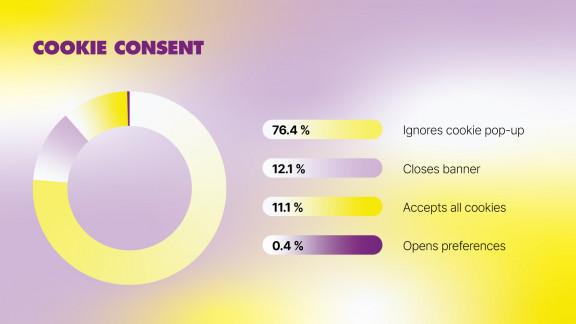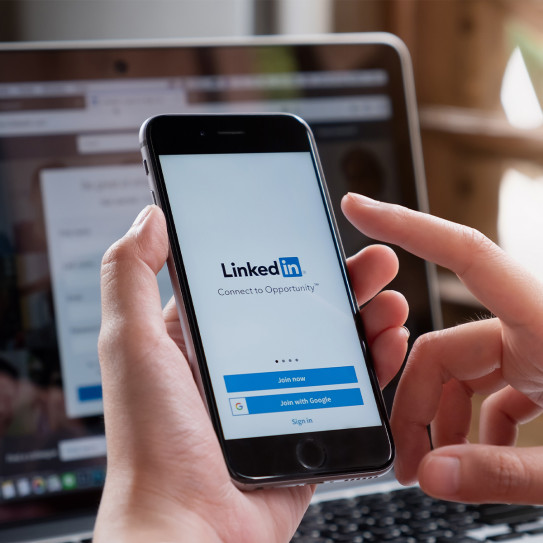
Discover solutions for a cookieless world
In this digital age the term “cookie” means more than a delicious snack to be enjoyed with a cup of coffee or tea. These little text files, which are placed on your computer when you visit a website, are very important to gauge customer behavior and to adapt the content of your website and campaigns. However, Google has announced they are phasing out third-party cookies in Google Chrome by the end of 2023, joining the efforts of other browsers like Safari and Mozilla Firefox. And with the launch of iOS14, Apple already implemented a specific consent form to allow tracking. Let’s find how you can prepare and still gather data in order to have successful digital campaigns.
Accept or reject cookies?
Welcome to a cookieless world: now what?
Ask yourself this question: what do you do when you visit a website, and a pop-up appears asking your consent to accept or reject cookies? Do you accept or deny this, or do you open the preferences to make a personal selection? Since GDPR it has been quite a challenge to get people to give consent for (all) tracking which naturally directly impacts the creation of remarketing audiences and measuring campaign performance. My team could see a drop between 10%-30% in measuring website visitors in Google Analytics, which is quite significant.
Without cookie consent, it is getting harder and harder to:
Accurate website analytics allows us insight into the success of a campaign and how people engage with the website. It also allows us to track users over different visits, which comes in handy if we want an overview of multi-channel attribution.
The data from third-party cookies – for example Facebook or Google advertising cookies – are used to measure when a user makes a purchase, visits a specific page or any other action after seeing an advertisement. If we don’t have this data anymore, we cannot attribute conversions to a campaign or optimize performance.
Retargeting campaigns are usually the ones that perform best and are also most profitable because the intended audience are people who have a certain intention to perform an action: buy something, read an article, engage with your content. However, if we can’t track website visitors anymore, this means we can’t retarget them either.
Moreover, a lot of the campaign delivery is done by algorithms which need data in order to perform optimally. If they don’t, they won’t be able to build accurate profiles anymore, so targeting will become less accurate.
What is the purpose of your cookies and a consent banner?
As I already stated, cookies are text files that are placed on an internet user’s computer when then visit a website, and in the case of third-party cookies they usually contain an ID to identify this person – a number or an existing online profile – and will collect data about them on different websites.
In order for them to do so, the internet user consents when visiting a website. This cookie/consent banner is mandatory on a website if personal user data is being stored, regardless of whether it is being stored or merely collected. Tracking can happen via a cookie, an IP-address, device fingerprinting, server-side tracking, etc. Therefore, a consent banner will still be required, even in a cookieless world.
A little refresher on different types of cookies:
|
|
First-party cookies |
Third-party cookies |
|
Definition |
Used to help websites keep track of user visits and activity. They help improve user experience and make internet browsing seamless. |
Used for ad retargeting and behavioral advertising. Adding tags to a page allows tracking a user across the website, and building a profile based on search habits to serve more relevant content |
|
Origin |
From visited website |
Doesn’t belong to the visited website |
|
Set by |
Owner of the website, using Javascript |
Loaded by third-party servers on the visited website |
|
Accessibility |
Work only on the website |
Accessible on any website that loads third-party cookies code |
|
Brower support |
All browsers, but a user is free to block them from their browser settings |
All browsers, but some browsers block them, and they are not loaded in incognito mode |
Learn more about first- and third-party cookies in one of our previous blogs.
Choose your new tracking recipe
A baker’s dozen of tracking solutions, depending on your needs
So, we have identified the crux of the problem; we want to be able to gather data in order to:
- Create relevant audiences
- Monitor the performance of campaigns
Let’s explore the different solutions we offer, and keep in mind: mixing and matching is allowed
Used for: Data collection
How? Data is gathered on your own website, and then sent to a connected server by means of the same domain name. There it can be sent to another platform like Facebook.
What? Because tracking is done via your own server instead of a browser, the cookies placed by the platforms are first-party cookies, not third-party cookies which would be blocked.. For example, when Google Analytics places a third-party cookie – it is placed by google.com, not yourdomain.com - to gather data like whether a user has visited the website before. You collect data from your website without the requirement of a third-party cookie, because tracking happens by your own server, not a browser.
Our opinion: This is our preferred method of tracking because it uses first-party cookies and can be implemented when developing your website. It is a very neat and efficient solution, which also avoids storing data on non-European servers, making it compliant with European GDPR legislation.
Benefits:
- Browsers that block third-party cookies won’t affect your website analytics
- More accurate data collection and tracking
- Event data can be sent to platforms like Facebook, Google Ads, TikTok, LinkdIn, so you gain a more consistent performance overview
- Might improve load time of the website – good for SEO – if tracking scripts are loaded on the server instead of the website
Consent: Users still need to consent to analytics tracking in order to capture their data and send it to the server. Remember: a consent banner is all about collecting data, not just cookies.

Used for: Data collection
How? This is a feature you can add to your existing Google Tag Manager (GTM) set-up.
What? It allows Google to read the consent banner status and, using machine learning., allows it to fill in missing data, anonymously of people who have not consented
Our opinion: This is a good option if you are already using Google products like Analytics, Ads.
Benefits:
- Compatible with Google products that are usually already in place
- Easily implemented into the consent banner
- Machine learning so it requires less manual handling
- Compatible with your own data warehouse or CRM system
Consent: Yes, as it uses the existing consent banner.
Used for: Data collection
How? You can use another analytics tool like Matomo.
What? It largely works like Google Analytics but because its data is stored on European servers, and not American ones, it is a preferred option within a GDPR-proof approach of your digital presence.
Our opinion: Since some countries have banned the use of Google services such as Analytics because they store data in the USA (no strict privacy laws), this is a good option, but you need to take into account some critical points, next to its benefits:
- Paid application
- Extra (paid) add-ons include heatmap, A/B-testing, recordings
- Connection with Google tools – Datastudio, Ads, Tag Manager - isn’t always easy
- Less functionalities unless you pay for them
- Not all parameters are detected, but workarounds are possible
- You can’t cross data with secondary dimensions
Therefore, we would advise to combine Google Analytics with a Matomo integration, so you can keep Google Analytics for in-depth data analysis (demographics, sources, etc.) using a consent banner, and Matomo for your basic data analysis for which you don’t require a consent banner and will allow you to check real volumes. The latter is very important when you do a lot of brand awareness campaigns.
Benefits:
- 100% data ownership
- Data is stored in Europe, so GDPR-proof
- Allows for cookieless tracking
- Historical Google Analytics data can be imported
Consent: Yes, as it uses the existing consent banner.

Used for: Campaign performance
How? Many advertising platforms offer an API which allows you to track data without third-party cookies (cfr. Server-side tracking).
What? Data is collected by the website and sent to a server on the same domain. This server then sends the data to the platform. For example, a Facebook pixel.
Our opinion: For all our campaigns we already use this feature as it allows us to work with retargeting of our audiences.
Availability:
- Facebook: yes, via server-side tracking or Facebook Gateway API
- TikTok: yes, server-side tracking
- Google Ads: yes, server-side tracking
- Pinterest: no, but working on it
- Twitter: no
- LinkedIn: no
Consent: Yes, as it uses the existing consent banner.
Used for: Retargeting the right audience
How? Many advertising platforms already made it possible to retarget people that engaged with your ad content before.
What? Luckily most platforms have made it possible already to retarget people that engaged with ad content before. For example, Facebook introduced the Facebook pixel. Another example would be someone has watched at least 10 seconds of your ad video, which means they show an interest in your content. Therefore, it would be relevant to show them a follow-up ad that drives them further down the funnel and lets them convert.
Our opinion: As retargeting is an essential part of funnel campaigns, which are also often the most performant brand campaigns, finding a new way to retarget users is very important. We already use a healthy mix of different ad formats, and when choosing our target audience, we don’t forget brand page followers and their look-alikes.
Availability:
- Facebook & Instagram: Instant Experience, shopping ads, lead gen forms, product catalogs
- TikTok: Instant Experience, Ad click
- Pinterest: Pin clicks, outbound clicks, saves, comments
- Twitter: Tweet likes, comments, retweets
- LinkedIn: lead gen forms, company page engagers, RSVP to an event
Consent: No, as it all happens within a platform, you don’t need a consent banner; you already gave your consent when you signed up to use the platform, thus giving an automatic consent to other users of the platform..
Used for: Retargeting the right audience
How? Use the data you have already gathered within your CRM system so it can be used for direct mailings, or other forms of contacting possible clients (like phone numbers), and if they have consented you can also target them in ad campaigns.
What? Your website and employees gather customer data every day: when people make a purchase, sign up for a loyalty program or a newsletter. If you use a good, and well-organized CRM, you can use this data to create complete profiles and import them into your digital media campaigns.
Our opinion: Fist-party data is invaluable for retargeting relevant audiences as you are very sure they have, or have had, an interest in your product/service at one point in time. Organizing this data so you can use it should be one of your top priorities. For our own solutions: have a look here.
Benefits:
- You manage your own database
- Create personas using your own data
- No third-party cookies
- Personalized communication which tends to perform better
Consent: Yes, as it uses the existing consent banner.
Used for: Retargeting the right audience
How? There are many platforms in existence that offer interaction and engagement with potential clients without the need for a website visit. For example, we have used Hashting in the past to gather data.
What? Hashting is a digital couponing system that allows people to sign up for promos and deals on their favorite messaging apps.
Our opinion: We used Hashting for one of our own clients – a pasta sauce brand – and we got some wonderful results because we linked fun, creative content to a frictionless cashback system. Potential clients who clicked on the ad, were sent to a custom landing page where they could complete a form for their cashback, including an upload function for your receipt. We could also enrich this data using the feedback option Hashting provided. All these results were visualized in a handy dashboard: ready for reporting.
Benefits of Hashting:
- Quick and efficient way to set up online and offline couponing
- No fuss for the end-consumer: cashback/couponing works digitally (app, website, WhatsApp)
- Delivers measurable leads thanks to a unique identifier (e.g. a phone number)
- Collecting leads can easily be done on your own website/dedicated landing page
- Clear reporting & insights
- Leads can be motivated by other promotions
Consent: No, as it doesn’t require a website visit.
Used for: Retargeting the right audience
How? By using specific platforms, such as Google Ads which allows you to target specific categories of websites.
What? Its way of working consists of placing the most appropriate ads within the right context to be engaged with – read, heard, watched – like when you would when publishing an ad in a magazine or newspaper you know your audience is fond of.
Our opinion: Post-GDPR, we see a rise in contextual advertising, from ads within podcasts to specific websites and offline use. It would be a useful exercise for your brand to at least think about where your audience might be likely to engage with your brand or content, without it being too obvious.
Benefits:
- No cookies or tracking
- Offline use as well
- Leverage of the ad platform’s data
- Machine learning
Consent: Not necessarily.
Conclusion
A cookieless world doesn’t mean the end of the world, but it should make you pause and assess your current ways of tracking and setting up your retargeting campaigns. That way you can see if there are any gaps in your workflows and concoct the perfect mix of data collection and retargeting options.
Intrigued but don’t know where to start? Or do you need a good sous-chef to assist you? Don’t hesitate to contact our experts to come up with the perfect recipe for your brand.




